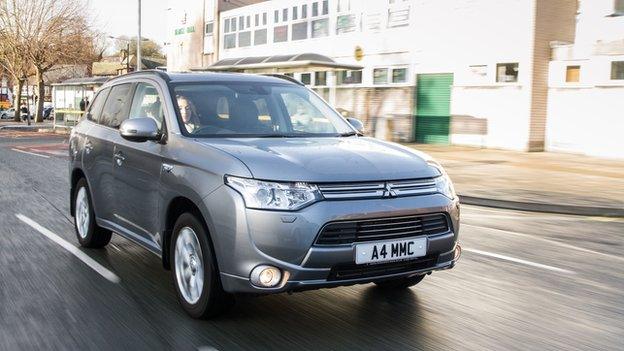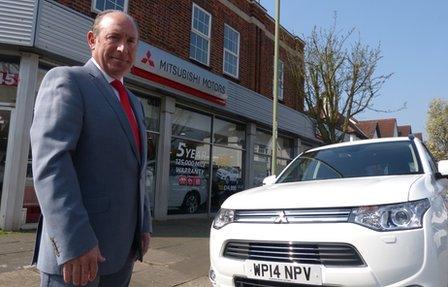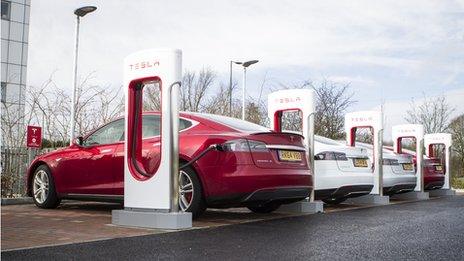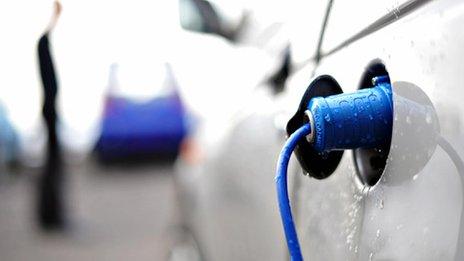If you want to buy an electric car, you may need to be speedy
- Published

Britain's best-selling plug-in electric car has sold 10,000 vehicles in the last year
Just before Christmas 2010, the then transport secretary, Philip Hammond, declared that 2011 would be the year of the electric car.
He couldn't have been more wrong.
However, had he said that 2015 would be the year - history might have judged him as prophetic.
Figures from the UK car industry this week suggest we might finally be waking up to the electric revolution.
In March 2015, we bought more than 6,000 "plug-in" cars, compared with around 1200 in March 2014 - a 400% increase.
Plug-in hybrids - which have a conventional engine as well as an electric motor - saw sales rise by 984% over the same period, according to the Society of Motor Manufacturers and Traders (SMMT), admittedly from a very low base.
Given the fall in the oil price, which has made conventional motoring cheaper, you might have thought that electric vehicles would be falling out of favour.
In fact, the opposite has happened.
Indeed, if the trend continues, we could well buy more than 30,000 electric vehicles this year alone.
But the good news is also the bad: The government's £5,000 subsidy on each new car will run out when a total of 50,000 have been sold - and that target could now be reached before the end of the year.
Incentives
So what has changed since 2011?
To start with, there are many more plug-in models to chose from. Then there were just six; now there are 27 models which qualify for the government grant.
The network of charging points has also expanded. There are now 3,000 places in the UK where you can plug in, and by doing so take advantage of motoring costs as low as 2p a mile.
"It's a classic rolling boulder," says Jim Holder, the editor of What Car? magazine.
"More manufacturers have come in, the infrastructure has grown, and there are a lot of incentives behind buying a car."
Those incentives have been key: Road tax exemption, free entry to London's congestion zone, and the fact that the government currently pays as much as £5,000 , externaltowards the cost of a car - the plug-in grant. Company car tax rates are also much lower (see below).
But beware. By my calculations, based on government and the SMMT figures, 31,000 plug-in grants have now been paid - leaving another 19,000 before the scheme ends.
Given that we bought 8,500 eligible cars in the first three months of 2015, the grants may well run out by the Autumn. If you're thinking of going electric, it may pay you to put your foot down.
The scheme is due to be reviewed in May, but as yet no one knows whether the subsidy will be extended.

Larry Wood believes customers will still buy electric cars, even without the subsidy
Car tax
At his show-room in north London, car dealer Larry Wood, of Hummingbird Motors, is unperturbed. The main reason is that Mitsubishi Outlander PHEV - a plug-in hybrid SUV - has proved so popular.
It is now Britain's best-selling electric car, with more than 10,000 sales in the last year. He believes customers won't stop buying them, even if the plug-in grant is no longer available.
"If that does run out in the future, I still think people will buy these cars, but it just makes them £5,000 cheaper," he says.
In any case, some of his best customers are businesses, for whom the capital cost is not the only consideration. The main attraction for them is a lower rate of car tax.
While the most polluting cars pay 35% in company car tax, electric cars - even though they used to be exempt - pay 5%.
As a result, any business with a fleet of vehicles could still save thousands of pounds a year by going electric.
Technology
Most of the problems initially associated with electric vehicles are gradually being resolved, or so the industry would have you believe.
"Range anxiety" - the fear of running out of charge - does not apply if you buy a hybrid car, which switches to its conventional engine as soon as the battery runs out of power.
Nevertheless, those who drive pure electric cars still worry about getting stranded.
"Range anxiety will never go away," says Jim Holder.
But ranges are being extended. Whereas a maximum range of 100 miles used to be typical, the latest cars offer well over that. General Motors hopes that its Bolt model, currently on the drawing board, will have a 200 mile range.
The super-expensive Tesla S - already on sale in the UK - will go for 310 miles without a charge, according to the manufacturer.
Another problem has been the cost of batteries, the main reason that electric cars are so pricey in the first place.
But advances in technology could make them cost-competitive with petrol engines in less than a decade, according to two Swedish scientists, external.

Tesla's fast-charge station in Maidstone, Kent
'Ferrari'
Time spent charging has been another bugbear of electric motorists - if you can find a charge point of course.
The government boasts there are now 7,000 in the UK, in 3,000 locations. 500 of those are "fast chargers", which can offer a 50% charge in as little as 20 minutes.
But in reality, most charging stops are going to be for at least half an hour.
And for motorists, understanding the rival charge point networks - and the different costs for using them - still requires some tenacity.
Public subsidies for infrastructure have also changed, with the government ending its specific grant of up to £7,500 per charge point.
However, there is still some support available for owners under the Electric Vehicle Homecharge Scheme, external, which pays householders up to £700 to have a charge point installed at home.
What is undeniable is that the appeal of the cars themselves has certainly improved.
Where once electric cars looked like garden shed conversions, the designers of BMW and Porsche have now worked magic.
Performance too has improved significantly.
"You now get instant torque away from the traffic lights," says Jim Holder. "Frankly, not even a Ferrari will beat you off the line."
- Published3 September 2014
- Published27 June 2014

- Published6 March 2014
